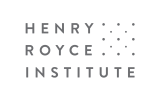© Pint of Science, 2025. All rights reserved.
Join us for our launch event - a little 'sip of science'. You will hear fascinating flash talks across multiple themes featuring some of Manchester's leading thinkers and researchers.
You Are More Than Stardust
Dr. Soheb Mandhai
(Postdoctoral Researcher)
The atoms that make up our bodies were produced by the death of former generations of stars. You may have heard the saying ""We are stardust"". Whilst that certainly holds true, there is a lot more to the story. Regular stars are unable to produce elements such as gold, platinum, and other rare earth metals. From the radioactive heating of the Earth's core, to societal structures, in this talk, I will explore events that can produce these elements and discuss the implications this has on life on Earth.
Being a Technician at Royce
Dr. Parnian Doostdar
(Technician at the Sustainable Materials Innovation Hub)
In this short talk, I will be talking about how the professional support staff support research activities. I will also provide examples of technical and scientific projects that I have been involved in as a member of the technical team at the Sustainable Materials Innovation Hub.
Leaf to Lenses: Electrowetting for Droplet Control
Karthik Kumaran Saravanan
(Dean's Doctoral scholar at The University of Manchester)
Wetting, the way liquids interact with surfaces, plays a role in both nature and daily life. From lotus leaf repelling water to gecko's incredible wall-scaling ability, wetting is behind many of nature's magic tricks. Yet, replicating these feats artificially proves challenging. Enter electrowetting: a simple voltage application allowing on-demand manipulation of droplets using electricity, revolutionising technologies like display screens and liquid lenses. However, challenges remain. Our quest? To unveil the perfect blend of materials for reversible electrowetting on conductive surfaces.
Modelling Atomic Lattice Rotations While Stretching Titanium Alloys at 1000 Degrees Celcius
Guy Bowker
(PhD Student at the University of Manchester)
Hot rolled titanium alloy sheet, commonly used in aircraft, has been investigated using x-rays while being stretched apart at high temperature (up to 1000C), and simulated using a powerful computing cluster. This was done to better understand the way in which titanium deforms at these high temperatures when shaping aircraft parts, improving their mechanical properties, so that aeroplanes require maintenance less often.
Longer lasting aircraft parts decrease the cost of flight. Additionally, reducing the number of times the aircraft needs to be maintained can lower overall carbon emissions.
Longer lasting aircraft parts decrease the cost of flight. Additionally, reducing the number of times the aircraft needs to be maintained can lower overall carbon emissions.
Biomaterials with Electrical Stimulation: From Lab to Clinic
Dr. Jose Ricardo Aguilar Cosme
(Research Associate at Henry Royce Institute)
Biomaterials are specially designed materials that can mimic the natural environment of cells in our body. By engineering biomaterials to replicate the cues present in our tissues, scientists can create a supportive environment that helps direct the behavior of stem cells. My main work is using electricity to direct stem cell behavior, Our body naturally experiences electric fields, which we aim to harness for producing a specific effect: new bone formation around titanium implants. Our aim is to help develop new non-invasive treatment strategies for a variety of patients and diseases.
Integrating Renewable Energy: Toward a Greener, Smarter, and More Sustainable Power System
Youhong Chen
(Postdoctoral Research Associate at the University of Manchester)
With the UK government committed to achieving zero carbon emissions by 2050, a significant transformation is underway in the energy system. This involves a shift from conventional energy resources to renewables.
However, the unpredictable nature of these renewable resources presents challenges in determining when, where, and how much of these energies will be available for electricity generation. To address the intermittent characteristics of renewable energy, recent years have witnessed the development of energy storage technology.
This presentation aims to illustrate a future vision for the power system characterized by the seamless integration of renewable energy sources, contributing to a greener, smarter, and more sustainable future. It will explore the potential challenges this transition may face and highlight how innovations in energy storage could offer viable solutions.
However, the unpredictable nature of these renewable resources presents challenges in determining when, where, and how much of these energies will be available for electricity generation. To address the intermittent characteristics of renewable energy, recent years have witnessed the development of energy storage technology.
This presentation aims to illustrate a future vision for the power system characterized by the seamless integration of renewable energy sources, contributing to a greener, smarter, and more sustainable future. It will explore the potential challenges this transition may face and highlight how innovations in energy storage could offer viable solutions.
An Introduction to Time Travel – Volcano Style!
Dr. Bridie Davies
(Postdoctoral Research Associate at the University of Manchester)
If a volcano erupts in the past and there’s no one around to post it on TikTok…did it even erupt? Volcanic eruptions have been shaping our planet and lives since long before the written word, let alone the internet. Understanding how and why volcanoes have erupted in the past is critical to anticipating future activity. On a planet where 800 million people live within a 100km of a volcano, considering past eruptions as dead and, sometimes quite literally, buried is not an option. Join me as I reveal the secrets of time travel, as harnessed by volcanologists of the world for the last 150 years.
The Building Blocks of Brain Tumours
Grace Gregory
(PhD Student at the University of Manchester)
Join us on a journey into the intricate world of brain tumours, where we explore the fundamental building blocks that shape their growth. Throughout this talk, we'll closely examine a rare disease that affects everyday people, each of whom lives with countless brain tumours of many different types. Together, we will answer the key questions… How do brain tumours actually begin? And how can we prevent their growth? But most importantly, what can each of us do to fight brain tumours together?
3D Model of Liver Tissue
Yiting Chen
(Postgraduate Researcher)
Liver diseases pose a huge challenge for the global medical system. Current treatment of liver transplantation is limited by various reasons such as lack of donors. Therefore, scientists are looking into building a liver model in the lab to mimic the liver, and ultimately build livers for patients, and self-assembly peptide hydrogel (SAPH) is a potential candidate for such applications. This project involves using various lab techniques to investigate the suitability of various types of SAPH as the material to build the liver.
A New Science of Strong Aircraft: or Why You Won’t Fall Out the Sky (hopefully)
Mark Taylor
(Researcher)
Forging is a centuries-old metalworking process, teaching us that repeatedly hammering hot steel shapes it and makes it stronger. We want to make metallic components without forging. Then build an aircraft out of them.
Additively manufacturing (3D printing) metals drastically reduces waste and therefore environmental impact, when compared to traditional processes. Unfortunately, additively manufactured metals are often weaker than their forged counterparts. However, with the right technique and a knowledge of crystallography (not something that can be bought at Glastonbury) it can work.
Additively manufacturing (3D printing) metals drastically reduces waste and therefore environmental impact, when compared to traditional processes. Unfortunately, additively manufactured metals are often weaker than their forged counterparts. However, with the right technique and a knowledge of crystallography (not something that can be bought at Glastonbury) it can work.
Map data © OpenStreetMap contributors.

